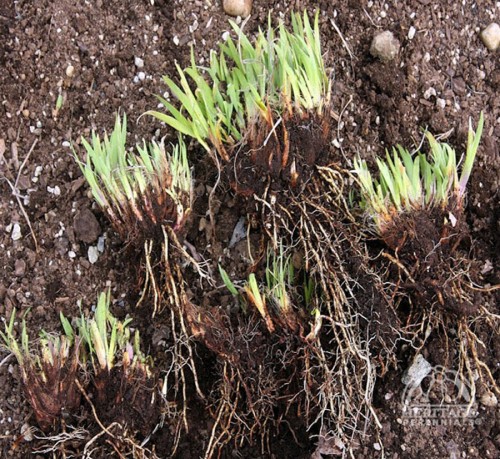In The Garden — Dividing Perennials
 By AMANDA ZAMBRANO
By AMANDA ZAMBRANO
Master Gardener Intern
One of my favorite spring garden tasks is dividing plants. Plants can be divided to control the size of the plants, rejuvenating old plants or increasing the number of plants.
How do you know if your perennials need dividing? Your flowers may be smaller than usual, or more sparse than usual. The center of the clump may be dying or hollowed out. The bottom foliage will be sparse and poor. Most perennials need division every 3-5 years, although there are some — like bleeding hearts — that never require division. If your plants look healthy, there is no reason to divide them unless you wish to increase the number of plantings.
The best time for dividing your summer and spring blooming plants is in the fall, while spring is the best option for your fall blooming plants. However, many plants tolerate dividing in either spring or fall. Never divide a plant while it is flowering.
Your plants will benefit from a little prep work before dividing. Pick a cooler, cloudy day for dividing, maybe even with some rain in the forecast; avoid hot or overly sunny days. A day or two before dividing, water the plants well, and prep the soil where you intend to plant your new divisions. Prune back stems and foliage to about 6-inch above the ground.
Many of your perennials will have either a spreading root system or a clumping root system. The type of root system will determine the best method for dividing the plant. To determine your root system, start by lifting the parent plant. Using a sharp garden shovel, dig down deeply on all four sides of the plan, about 4 to 6 inches out. Using your shovel, pry the plant out of the ground. Shake off all the loose soil.
Spreading root systems — plants like asters, rudbeckia, geranium, cone-flowers, or coreopsis — have many slender, small, matted roots with no distinct origin. Some can be pulled apart with your fingers, or cut apart with shears or a knife. Particularly large plants may require pulling apart with digging forks. Separate spreading root systems into clumps containing three to five vigorous shoots. Discard anything small, woody or weak.
 Clumping root systems — plants like bleeding heart, canna, daylily, hosta ornamental grasses or sedum — tend to originate from a central clump. You’ll probably need to cut these through the crown of the plant with a sharp knife or pry them apart with digging forks. Your divisions require at least one eye or bud; larger divisions will want at least three eyes or buds.
Clumping root systems — plants like bleeding heart, canna, daylily, hosta ornamental grasses or sedum — tend to originate from a central clump. You’ll probably need to cut these through the crown of the plant with a sharp knife or pry them apart with digging forks. Your divisions require at least one eye or bud; larger divisions will want at least three eyes or buds.
Be sure your divisions don’t dry out. After dividing them, keep them in a bucket of water until you’re ready to replant. Trim any broken roots before replanting. Plant in your prepared soil or containers, making sure the roots are placed in at the same depth as the parent plant. Fill in with plenty of soil, and water well.
Amanda Zambrano is the director of advancement at Grace Village Retirement Community. She is a master gardener intern, just learning the ins and outs of successful gardening.
Along with her master gardener volunteering, Amanda serves on the board of directors for the Wagon Wheel Center for the Arts, the Symphony of the Lakes committee and a Kosciusko County Community Foundation scholarship committee. She plays flute for the Symphony of the Lakes and enjoys hand-quilting, baking and reading. She is also an occasional blogger. Amanda lives in Warsaw with her husband Dan and her son Alexander.

